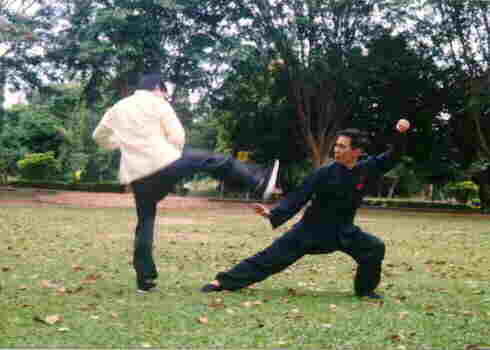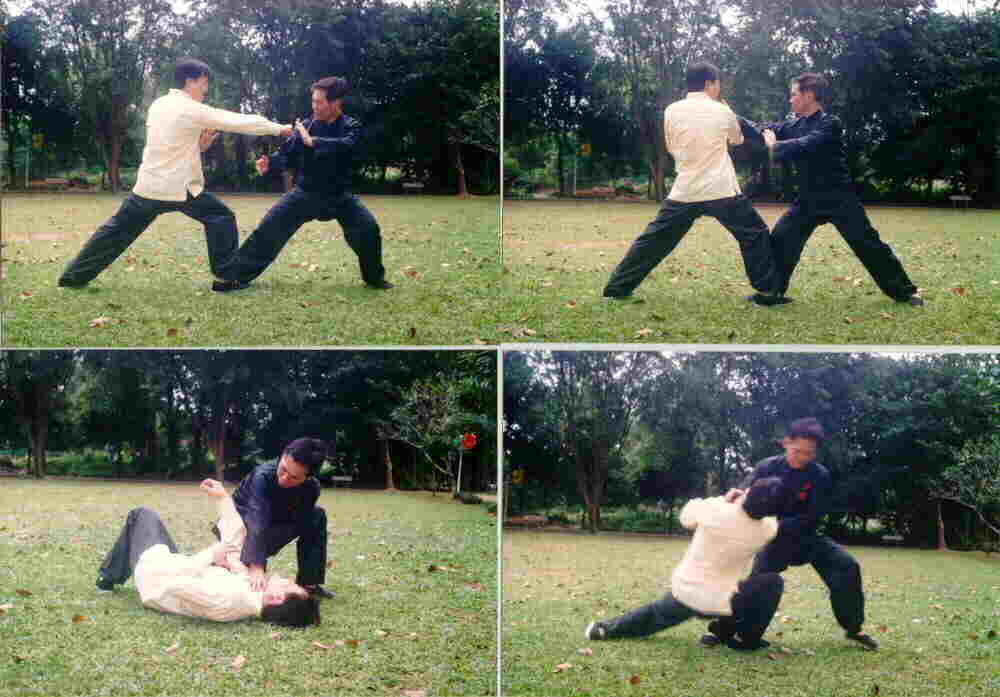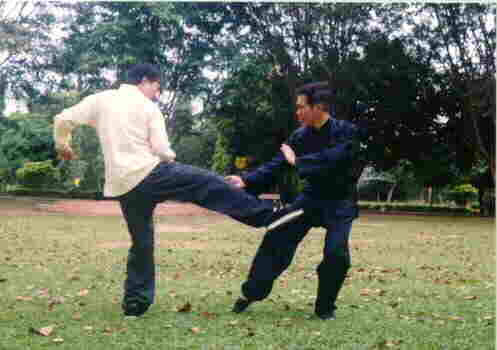COMBAT APPLICATION OF TAIJIQUAN

Can Taijiquan be Used for Fighting?
Many people, especially in the West, will be quite surprised that Taijiquan can be effectively used for fighting. In fact the term "Taijiquan" means "cosmos martial art". All great Taijiquan masters since classical times have practised Taijiquan as a martial art and all Taijiquan classics have described it as a martial art, although the older texts often paid more attention to its function in spiritual cultivation than in combat efficiency.If you do not know the martial dimension of Taijiquan, you would have missed the essence of this wonderful art, and would probably have practised it as a dance. Even if your main intention of practising Taijiquan is for health reasons, you would have missed the best health benefits of Taijiquan if you do not practise it as a martial art. This is because if you practise Taijiquan as a dance, the most you can get are the benefits a dance can give such as flexibility, elegance, loosening muscles and blood circulation. The proverbial good health of a Taijiquan master, including his internal power, remarkable stamina and mental freshness, is obtainable only if you practise it as a martial art, i.e. if you train yourself to become a formidable fighter whereby these health features are essential.
Amongst the various dimensions of Taijiquan, those of internal force cultivation and combat application are necessary if you train Taijiquan as a martial art. Without internal force a Taijiquan exponent would have no stamina to last a fight and no striking power to subdue an opponent; without knowing how to apply Taijiquan techniques to combat he would be helpless when attacked.
Manifesting the yin-yang principle of the Taiji unity, internal force and combat application compliment each other. If a Taijiquan exponent has only internal force but no combat application, he may be able to give impressive demonstration of his power, such as taking punches without sustaining injury or sending a demonstration partner flying backward, but he would be unable to defend himself in a real fight. If he has only combat application but no internal force, he may be able to discuss the wonderful combative techniques of Taijiquan intellectually or perform some pre-arranged sparring elegantly, yet when involved in a real fight he may be easily defeated by a clumsy but mechanically stronger opponent. Internal force cultivation will be explained in another webpage; this webpage explain some combat applications of Taijiquan. All styles of Taijiquan are effective for combat; the examples illustrated here are taken from the Yang style.
The Flowing Movement of Taijiquan
Some students may have heard that the First Patriarch of Yang Style Taijiquan, Yang Lu Chan, defeated all his challengers and he used only one Taijiquan pattern known as "Grasping Sparrow's Tail". Although many people may find it hard to believe, it is true that if you have sufficient internal force and are skillful in combat application, you can successfully employ just this one pattern, "Grasping Sparrow's Tail", to overcome virtually any forms of attack, irrespective of whether the attacks are punches, kicks, throws or holds!

Photos 1 to 4, which should be viewed clockwise, illustrate how this pattern may be used to counter a thrust punch, then fell the opponent onto the ground. In Photo 1 the opponent (illustrated by Goh Kok Hin) attacks with a thrust punch, which is a very common form of attack. The exponent (illustrated by myself), beginning the Grasping Sparrow's Tail pattern, shifts his body backward slightly to avoid the punch.. Without any break, he wards off the thrust punch with the peng technique, Photo 2, then grips the opponent's throat and follows through with the li technique.

Continuing smoothly in the same flowing movement, he fells the opponent onto the ground, Photo 3. Notice that the exponent's grip is still on the opponent's throat although the latter is already on the ground, Photo 4. If the exponent lets go his grip and walks away, the opponent could jump up and continue fighting, possibly striking the former from behind. In a life-death struggle, which fortunately are extremely rare nowadays, the exponent could maim or even kill the opponent by gripping hard at the latter's throat and tearing out the Adam's apple. But Taijiquan exponents, in line with the Taoist reverence for life, usually stop short of this fatal move and let the opponent go, after demonstrating his combative superiority.
Starting Later but Arriving Earlier
Photos 5 to 7 illustrate a Taijiquan counter against a continuous attack. In Photo 5 the opponent attacks with a left palm strike to the throat, and the exponent responds with the warding technique in Grasping Sparrow's Tail. Before the exponent could continue with any movement, the opponent instantly executes a thrust punch to the exponent's chest, with the first palm strike acting as a feigning move.The exponent shifts his front right leg backward into the momentary unicorn step and wards off the attack with a left vertical arm block, Photo 6. Without any break, he moves his back left leg forward into a bow-arrow stance, and strikes the opponent's side-ribs with a vertical fist, with his left arm still in contact with the opponent's attacking arm. This Taijiquan pattern is called "Looking at the Fist below the Sleeves", Photo 7. When executed skillfully, the exponent would hit the opponent at the moment when the latter's movement is just spent, implementing the Taijiquan tactic of "starting later but arriving earlier".
Effective Counters against Kicks
It is a common mis-conception amongst some student to think kicks are more formidable than punches because they are (apparently) more powerful and have longer reach. Actually among the four categories of attacks - hand strikes, kicks, felling and grips - kicks are technically the easiest to counter.

One simple and efficient way to counter almost any kicks is the Taijiquan pattern called "Low Single Whip". As the opponent kicks, just lower your stance in the Low Single Whip pattern, as shown in Photo 8 above. When you have become more skillful, instantly the moment the kick is spent, you move forward to counter strike the opponent, often before he could recover his kicking leg.

Some students seem to believe that the higher one can kick the better is his martial ability. Personally I find high kicks both unsightly to watch, as they expose vital parts that customarily need to be covered and protected, and technically inferior in combat as the kicking attacker offers so many advantages to his opponent without his opponent having to do anything. One simple, effective counter against high kicks is the pattern "Fan through the Back", Photo 9 above. If someone gives you a high kick, shift your body backward without moving your legs, and continuing the smooth movement move forward, floating his kicking leg with one hand, and striking his groin (if you want to be nasty) or his thigh (if compassionate) with the other hand.

In contrast with the high kick, the low kick is inconspicuous and deadly. One effective counter against the low kick is "Needle at the Sea Bottom", Photo 10. When an opponent executes a low kick at you, move your front leg backward, but still keeping it in front of your other leg, into the false-leg stance, and sweep your palm strike at the shin of the opponent's kicking leg. As soon as the opponent places his leg on the ground in front, or brings it back behind his other leg, you move in swiftly to strike him with one hand while covering yourself with the other hand. "Jade Girl Threads the Shuttle" or "Fan through the Back" (which are actually quite similar) would be an appropriate follow-up pattern.

If your attacker executes a round-house kick, an excellent counter you may use is "Cross-Hands Thrust Kick", Photo 11. As his round-house kick is approaching, you move diagonally to the other side and execute the thrust kick. You can kick at his abdominal energy field or groin, but to avoid hurting him seriously, you kick at his thigh, manifesting not just your combat superiority but also your compassion.
Even a brief study of its combat application as expounded here demonstrates not only the efficiency but also the elegance and profundity of Taijiquan as a martial art. Its combative movements are graceful and poetic, without the staccato action, muscular exertion and emotional tension characteristic of some other martial systems. Its combative principles are profound, exploiting the opponent's weakness to the full without giving away any advantages.
It is significant to remember that combat application of techniques and tactics is only one aspect of its martial function. The Taijiquan exponent must also develop internal force to back up the effective techniques and tactics in combat.
Moreover, combat efficiency is only one of the many benefits of Taijiquan training. Masters have generalized the attainment in Taijiquan into three major levels. At the first level Taijiquan promotes good health; at the intermediate level it is very effective for self defence, and at the highest level it leads to spiritual fulfilment.
